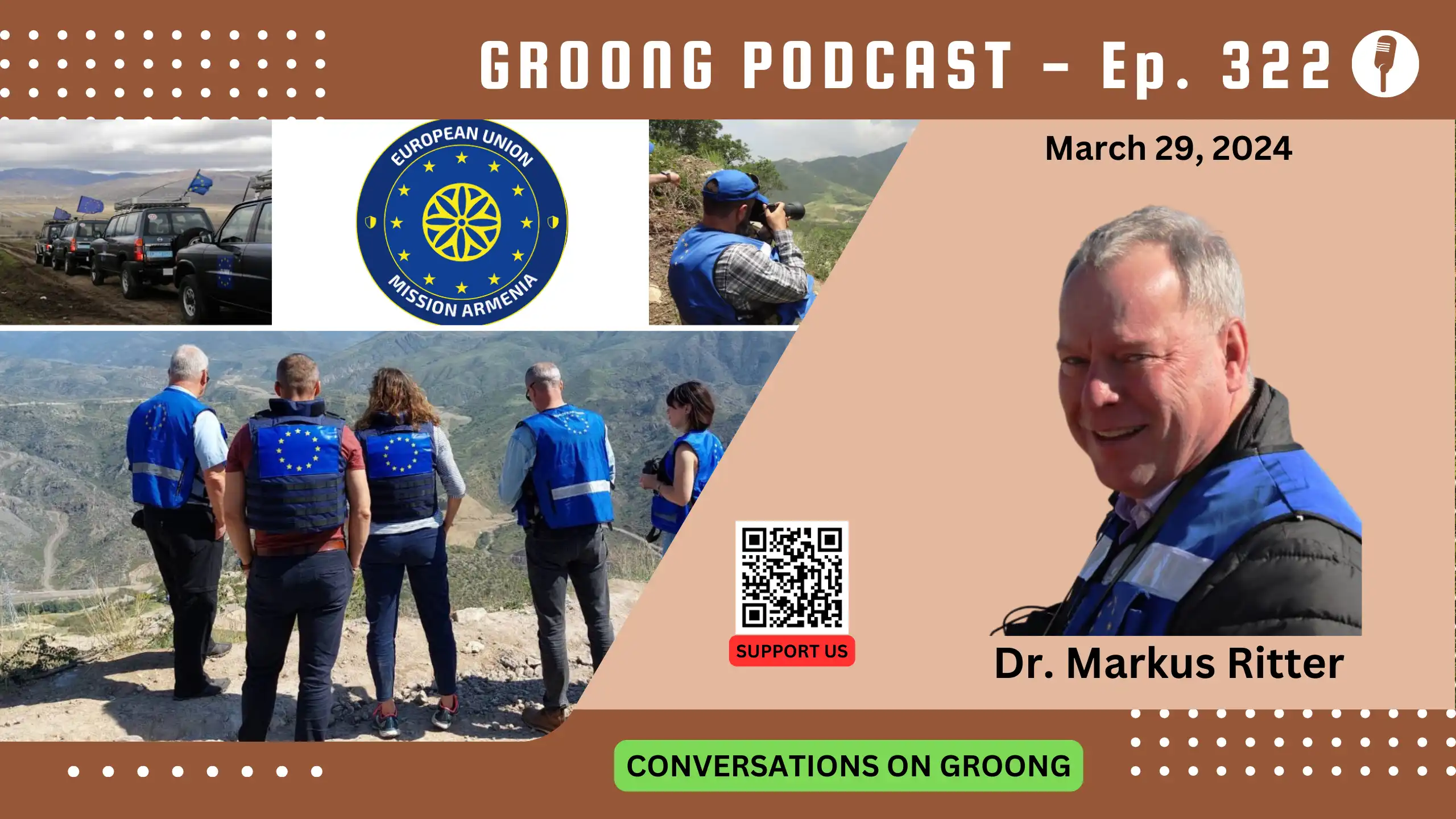
Groong Links:
Topics:
- Mission Details
- Mission & Goals
- Operational Details
- Communication
- Immunity
- Perceptions from Neighboring Countries
- Incidents
- August 15 ,2023
- Nerkin Hand
Guest:
Episode 322 | Recorded: March 26, 2024
Show Notes
The transcript for this episode can be found here: Markus Ritter - The European Union Mission in Armenia | Ep 322 - Mar 29, 2024.
The European Union Mission in Armenia
Dr. Ritter, you have a rich career as a law enforcement official and reading your bio, we learned that you have also participated in five international deployments. Since this is your first visit to our podcast, and hopefully not the last, would you mind telling our listeners a little more about your background?
Questions:
- Why did you choose this career?
- How did you come across the opportunity to participate in international deployments?
Mission Details
The EU mission recently celebrated its one year anniversary in Armenia. It was established in February 2023 and has a mandate that lasts 2 years. Having recently announced Full Operational Capacity, the mission has six Forward Operating Bases (FOBs) in Kapan, Goris, Jermuk, Yeghegnadzor, Martuni, and Ijevan.
Questions:
- Can you give us a more detailed summary of the goal of the EU observer mission in Armenia?
- Has the EUMA been effective in reaching its goal?
- Do you see an end to the mission, or do you expect its mandate to be re-upped?
- What does the average operational day of the EUMA look like?
The EUMA is deployed inside Armenia, observing the border with Azerbaijan. This means that there is some kind of a de-facto border that is being watched.
Questions:
- What is the border that the EUMA is observing based on?
- Is there an understanding of such a border between Armenia and Azerbaijan? What is that understanding?
- What technologies and tools does the EUMA use? Are satellite data and imagery part of the toolkit?
- Whose data do they use? Do they share it with anyone else?
Since its establishment, there has been some controversy around the operations of the mission, specifically related to reporting structure. It was a surprise to the journalist and analyst community that reports issued by the EUMA may not be public.
Questions:
- Can you tell us what sort of reports the EUMA generates?
- How frequently? Who receives them?
- EU?
- Government of Armenia?
- Government of Azerbaijan?
- Are the reports available to the public, or the media?
- Why? Or why not?
- Is there a precedent for peacekeeping or monitoring missions with a secret, or at least non-public, structure?
- For example, the Russian peacekeeping unit in Nagorno Karabakh used to publish daily reports.
The EUMA has limited resources. Basically currently 100 people with plans to grow to 200, in teams of 2, patrolling over 1,000 kilometers of border. So clearly they can’t be everywhere all the time. We have read that the EUMA communicates its planned observations to both the Armenian as well as Azerbaijani sides. The EUMA has never observed any of the incidents that have claimed the lives of Armenian border guards.
Questions:
- Why does the Azerbaijani side need to be informed?
- What information do they pass along to Azerbaijan?
- How much lead time do you need to give to Azerbaijan?
- What information is passed along to the Armenian government?
In February 2023, shortly before opening of the mission, Pashinyan, in a speech to the parliament, said that part of the goal of the EUMA is to “make sure that #Armenia and #Russia are not planning to attack #Azerbaijan." We recall that Azerbaijan tried to convince the EU that they were concerned that this could happen.
Questions:
- How would the EUMA “prove” this? And is it part of its duties to do so?
Turkey has been largely silent on the presence of western observers in Armenia, but Iran and Russia, and in fact Azerbaijan, have been very explicitly negative on the presence of the EUMA. They believe that regional issues should be resolved by regional players. Iran has also said that they do not trust the western observers because they don’t know what the mission is doing.
Questions:
- How would you respond to Iran, or how would you tell them that contrary to their assertions that you are a destabilizing force, you are in fact a stabilizing force in the region?
- Does the mission observe the Armenian-Iranian border?
Pashinyan has asked the Russian border guards at Zvartnots airport to leave. He has also frozen activities within the CSTO. It is understood that Pashinyan is pivoting Armenia’s security architecture towards the west.
Question:
- If the Russians were to leave Armenia, could the observer mission be transformed into an armed peacekeeping mission?
Most recently the mission received diplomatic immunity in Armenia.
Questions:
- Was this requested, and what was the need for such immunity?
- Is there precedent for such missions to have diplomatic level immunity?
- Can you clarify whether this is blanket immunity (like ambassadors have) or “functional immunity” for acts committed during the performance of the monitoring duties?
Incidents
Let’s talk about a couple of specific incidents that have stayed in the minds of Armenians.
Back in August (15) of 2023, the Armenian MoD reported that the Azeri forces had opened fire on EU observer positions. The EUMA was quick to deny the report and labeled it “Fake News”. Later the mission came around to admit that they were present.
That cover up caused even Armenian citizens to lose some trust in the mission.
Question:
- Why did the EUMA feel the need to cover up Azeri responsibility for that act?
Incident Details
First the Armenian Defense Ministry reported that the EUMA was targeted. The EUMA immediately issued a “Fake News” report:

Then a video was released proving they were shot at and the EUMA guys hiding:
They then deleted their tweet and issued a “Correcting Tweet”
Nerkin Hand
We can talk about the Nerkin Hand incident and the allegations they made against the Russians. * Clarify if the Russians have blocked them and what the specifics are? * Why do they need to go into the valley of Nerkin Hand, when it would be better observed from the road? There are geolocated photos of the EUMA actually doing monitoring from this position (see location marked as EUMA) in September 2023.
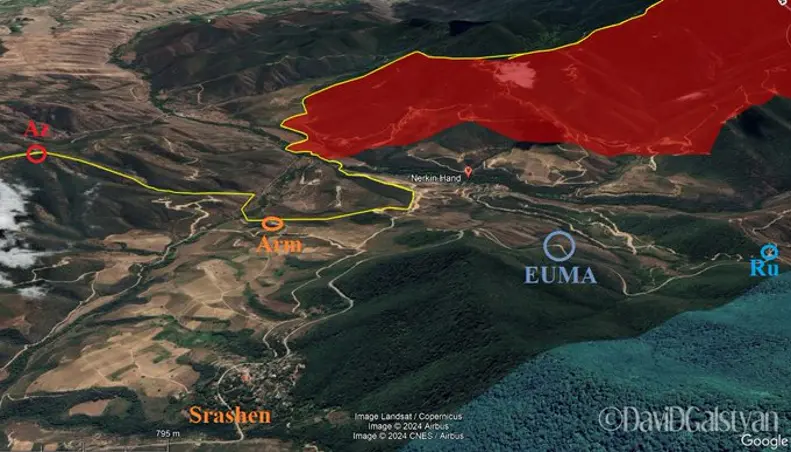
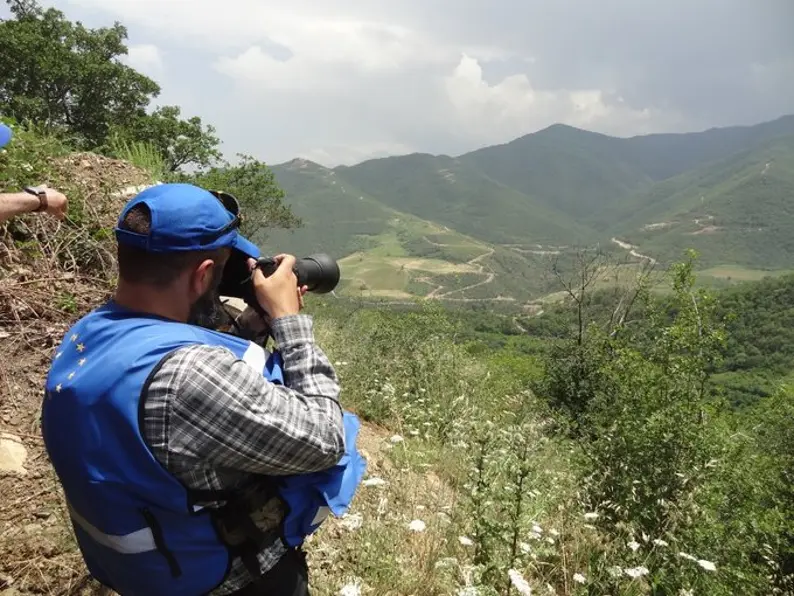
Wrap-up
All right, that’s our show, we hope you found it useful. Please find us on Social Media and follow us everywhere you get your Armenian news.
Thanks to Laura Osborn for the music on our podcasts.
Guests
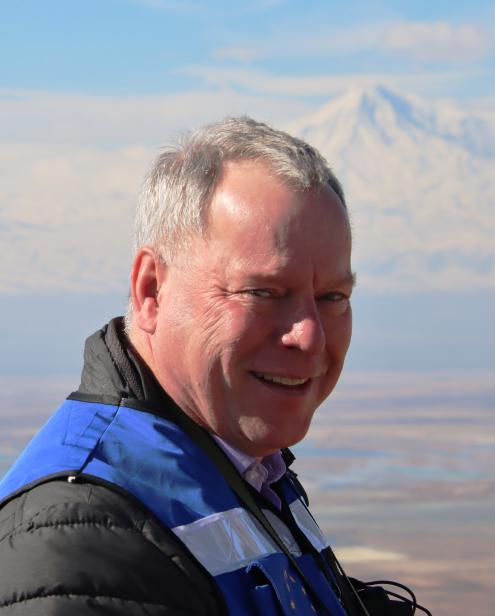
Markus Ritter
Dr. Markus Ritter is the Head of Mission of the European Union Mission in Armenia (EUMA). He is a senior police officer with extensive experience on national and international level. During his 27 years of professional career with the German Federal Police, he held various leadership positions on executive and staff level, and has gained extensive experience during five international deployments.
Hosts
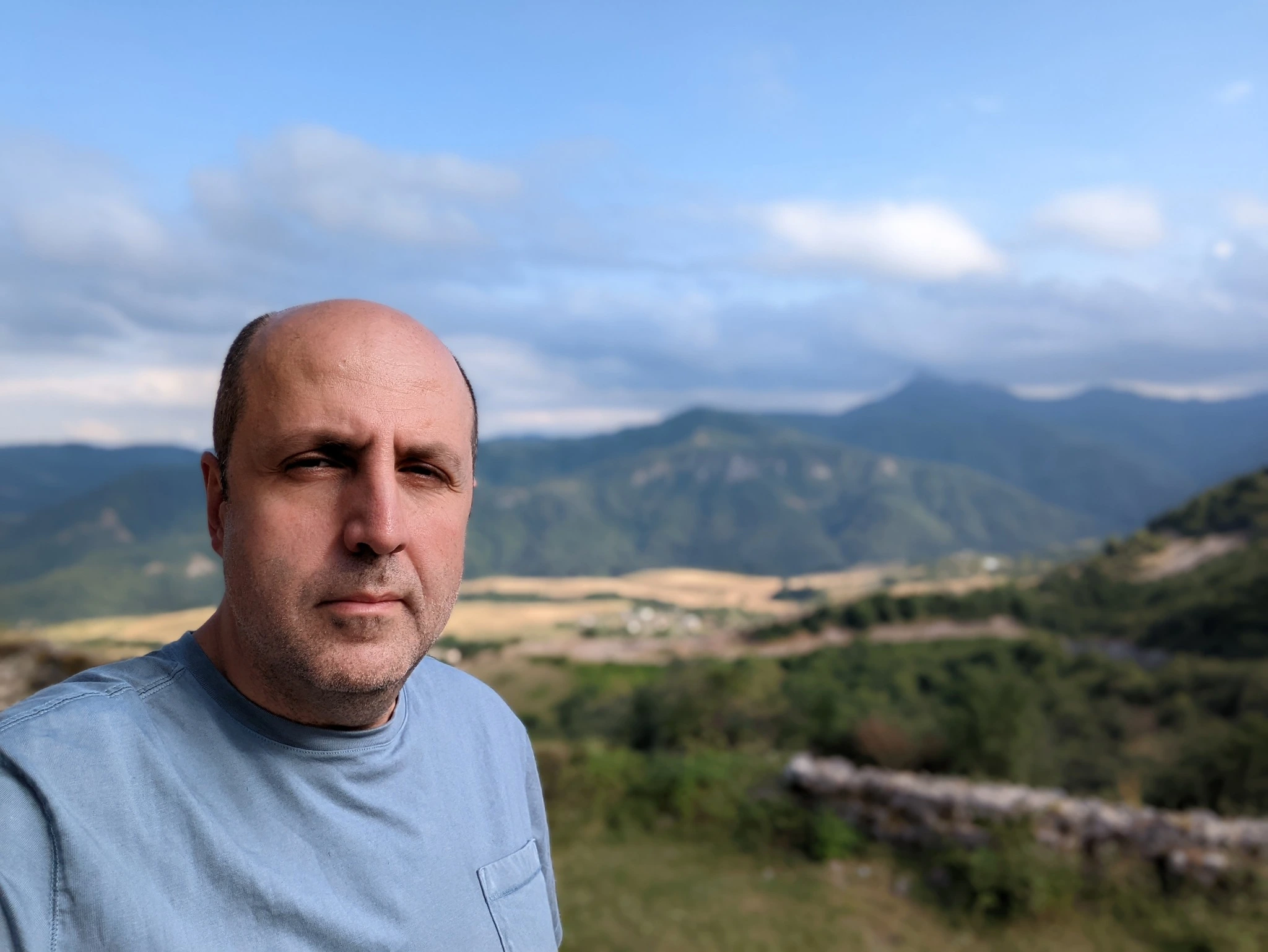
Hovik Manucharyan
Hovik Manucharyan is an information security engineer who moved from Seattle to Armenia in 2022. He co-founded the ANN/Groong podcast in 2020 and has been a contributor to Groong News since the late 1990s.
Disclaimer: The views expressed by Hovik Manucharyan on the ANN/Groong podcast are his own and do not necessarily reflect the opinions of his employer or any other organization.
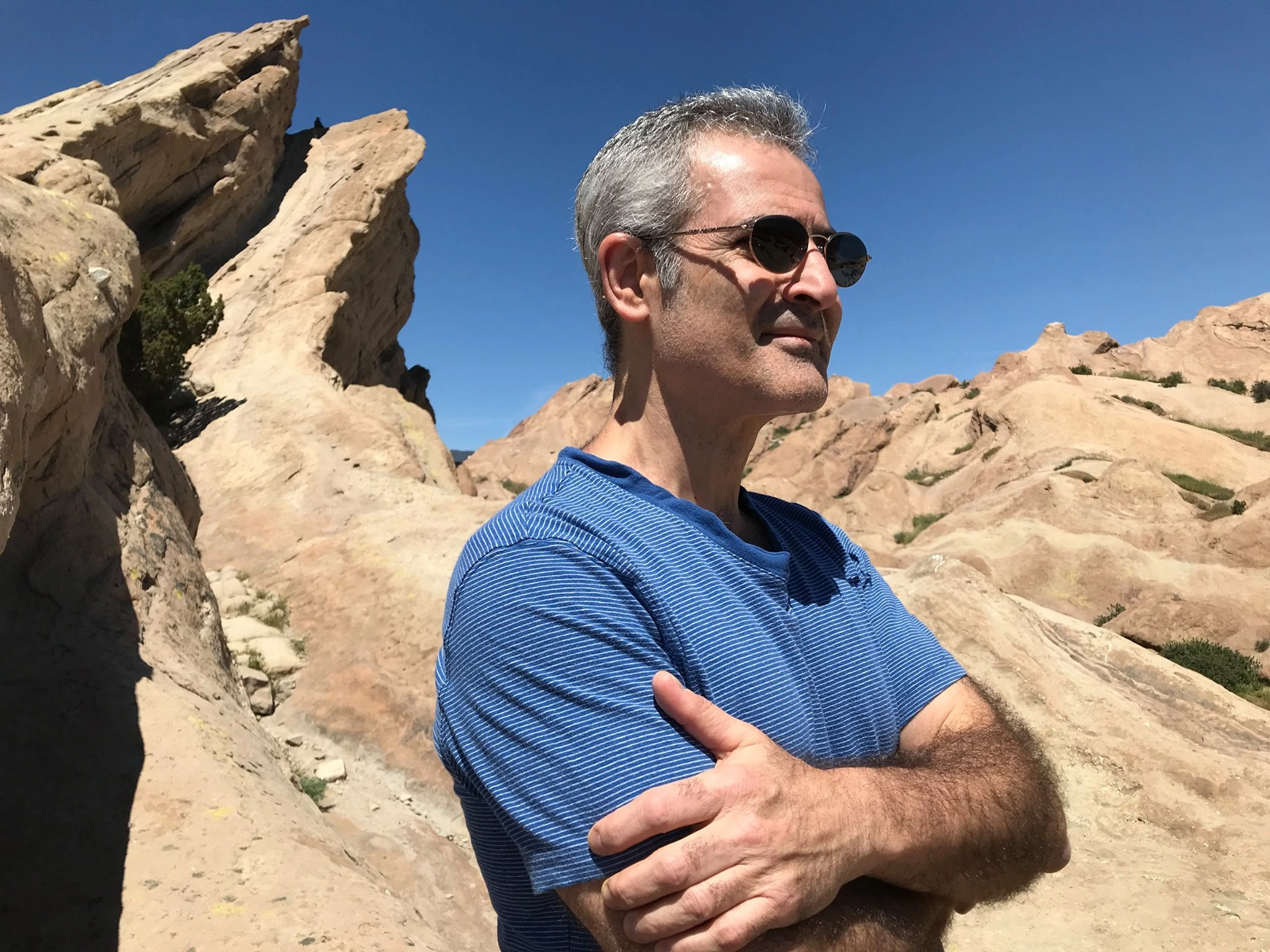
Asbed Bedrossian
Asbed Bedrossian is an IT professional, and for years oversaw the central IT enterprise infrastructure and services at USC. His decades of experience spanned across IT strategy, enterprise architecture, infrastructure, cybersecurity, enterprise applications, data center operations, high performance computing, ITSM, ITPM, and more.
Asbed founded the Armenian News Network Groong circa 1989/1990, and co-founded the ANN/Groong podcast in 2020.